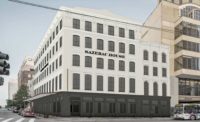Historic Space Becomes Contemporary Facility

The upper two floors of the century-old building that is home to the New Orleans Contemporary Arts Center soon will also house The Shop, a coworking space for 350 to 400 professionals.
PHOTO COURTESY OF THE NEW ORLEANS CONTEMPORARY ARTS CENTER

Distinctive elements of The Shop include an open architectural staircase, concrete slab flooring and ample common space.
RENDERING COURTESY OF THE DOMAIN COS.

Open ceilings will expose the building’s original timber beams, and 85 steel windows will be replaced with historical replicas.
PHOTO COURTESY OF PALMISANO CONTRACTORS

A concrete platform seating area, shown under construction, is one of several gathering spaces designed to encourage collaboration.
PHOTO COURTESY OF PALMISANO CONTRACTORS




Preserving the features of a century-old building while also transforming it into a new space and keeping the building open to the public during a seven-month rebuild required some creative thinking by the construction team working on The Shop, a co-working space in downtown New Orleans.
This 40,000-sq-ft, $13-million project redevelops the upper two floors of an architecturally significant, four-story building into a contemporary, open workspace that can accommodate 350 to 400 professionals. It also will include 70 private offices. Palmisano Contractors of New Orleans is the general contractor. The project includes demolishing and reconstructing the third and fourth floors.
Work is taking place as daily operations continue at the New Orleans Contemporary Arts Center, which occupies the first and second floors of the building. Also underway is a related renovation of the CAC facility, which will create new space for visual and performing arts programming.
Design firm Eskew+Dumez+Ripple aimed to preserve the architecture of New Orleans’ Warehouse District and honor the building’s historic roots while adding elements that reflect the forward-thinking, entrepreneurial spirit of the facility.
The CAC and the developer of The Shop say they want the project to serve as a model for the creative reuse of facilities throughout the country.
“The space at the Contemporary Arts Center is really special—a historic warehouse with a lot of character and classic design elements,” says Matt Schwartz, principal with The Domain Cos., the developer. “Our goal with The Shop is to work within this beautiful space to optimize it for connectivity, so we partnered with Eskew+Dumez+Ripple to achieve this through design.”
The project is within budget and on track to wrap up by the end of June, making for an early summer opening, Schwartz adds.
The CAC had to remain open for business during construction because of its ongoing programs and exhibitions, says facility spokesman Samuel Oliver. “The idea of closing for a year was unimaginable,” he says.
Early start
To accommodate the CAC staff, patrons and events, Palmisano’s team worked early hours and took steps to limit the noise workers made during construction. For about a month at the start of the project, crews began work at 3:00 a.m. and finished in time for the center to open at 11:00 each day, explains Erin Comeaux, senior project manager for Palmisano Contractors. The contractor also arranged to have construction materials delivered early in the morning so as not to disrupt business operations.
Because the center schedules special events for the public, including performances, exhibition openings and film screenings, construction crews have had to clear out their tools and clean up dust and building materials any time an event takes place.
The fact that most of the construction is relegated to the upper two floors reduces impacts on the exhibition space on the lower floors. But open communication to schedule around museum events has been crucial, Schwartz says.
“The CAC is also taking the opportunity to renovate during this time, so our biggest focus is on coordination and timing,” he says.
For example, when it came time to install glass in place of drywall in the building, work crews had to coordinate with the CAC to figure out a time that worked best for them to set up the 270 linear ft of scaffolding that the project required on the third and fourth floors, and then install the glass, which included 1,000 sq ft of 9-ft-tall glass in the atrium alone.
“It’s a lot of coordination and making sure the CAC staff is up to speed on the construction process and where we are in construction and what could potentially affect them,” Comeaux says. “Typically, on new construction you would just do what you need to do.”
Getting building materials to the third and fourth floors of the building—all while the first and second floors are occupied—hasn’t been easy. Workers have transported materials in up and down elevators and have used a 120-ft crane to lift materials through window openings. That includes beams, steel, all the glass for the build-out and the two sets of architectural stairs that would visually anchor the space. They also had to make sure the materials fit through these openings to begin with. “You kind of have to be creative,” Comeaux says.
Coordination with the CAC, the city and tenants was also necessary when it came time for Palmisano to bring in trucks to place concrete and perform other tasks that could potentially disrupt the neighborhood.
Architectural History
The building dates back roughly 100 years. But it was perhaps best known as being owned by the Besthoff family, which used the facility as a warehouse, ice cream factory and storefront for its drugstore chain K&B, short for Katz & Besthoff. The CAC came to lease the first two floors of the building in 1976 and continued to do so through the era when K&B sold its business in 1997.
The Besthoff family ended up donating the entire building to the CAC in 1999. Since then, the CAC has been looking for a way to properly develop the space while providing a steady stream of revenue for the nonprofit.
About a year ago, the Domain Cos. came through with its proposal for The Shop. Domain was also the firm behind the South Market District development of stylish residences, trendy restaurants and high-end retail just a few blocks from the CAC.
“The Shop is very much inspired by its location,” Schwartz said. “When space became available on the upper floors of the CAC in downtown New Orleans, we saw an opportunity to develop a totally unique project for the city.”
Palmisano has been tasked with bringing to life the facility’s gathering, working and meeting spaces, which were designed with productivity and collaboration in mind. Distinctive elements include an open architectural staircase connecting the third and fourth floors, ample common space and a roof deck for lounging and networking. The space also features various conference rooms and office configurations.
“The Contemporary Arts Center has served multiple purposes in its long history, and we respect its historic significance,” Schwartz says. “That’s why it’s so important to honor the architectural and cultural traditions of the building and neighborhood while thoughtfully incorporating modern elements.”
Part of what makes the project unique is its use of open ceilings, which expose the existing joists, columns and the old industrial framing as well as the wiring, ductwork and conduits. The space will maintain its industrial feel while incorporating glass offices with storefront-style entrances for a more open and modern floor plan.
To enhance The Shop’s industrial look, plans call for Palmisano to place a 19,000-sq-ft concrete slab as flooring on the third floor but keep the existing pine floors on the fourth level after refinishing them. The original timber ceiling beams will remain visible, and the perimeter walls are exposed brick that is original to the building.
“Much of the shell of the old building will still be exposed,” Comeaux says. Most of the brick walls were already exposed when construction began, but the contractor had to address the fact that the walls that would remain in place did not have insulation.
The windows were another aspect that was considered key to maintaining the building’s historic appearance while allowing natural light to shine throughout the space. The windows on the upper two floors are being replaced with reproductions of the original window design. Palmisano is replacing 85 of the building’s existing steel windows with historical replicas.
Restoring the old windows proved to be challenging because the brick surrounding the openings had deteriorated over time. Workers had to reframe several openings with treated 2x8s just to install the new windows. They also used non-shrink grout to fill the voids in the brick and waterproofed the openings to prep for the new windows.
“As in any renovation of an existing building, you never know what you’re going to discover,” Comeaux says. “And it’s just making provisions on what we found and where we go from here.”
Palmisano is replacing all the building’s skylights with new skylights and restoring the exterior of the building. This involves repainting the CAC sign and refurbishing the wood-frame windows on the lower floors.
The contractor is also working to improve the building’s efficiency and get a higher R-value, or measure of resistance to heat flow, for the building’s roof by adding a cooling tower to feed air conditioning to all four floors.
The replacement will be a three-day turnaround process in which the existing cooling tower will be disconnected and removed from the roof. The new cooling tower will be installed on the roof with the necessary pumps and piping. All the piping was fabricated beforehand to speed up the installation.
Palmisano estimates that as of late March, crews had logged roughly 20,000 man-hours with roughly 40,000 or more to go.







